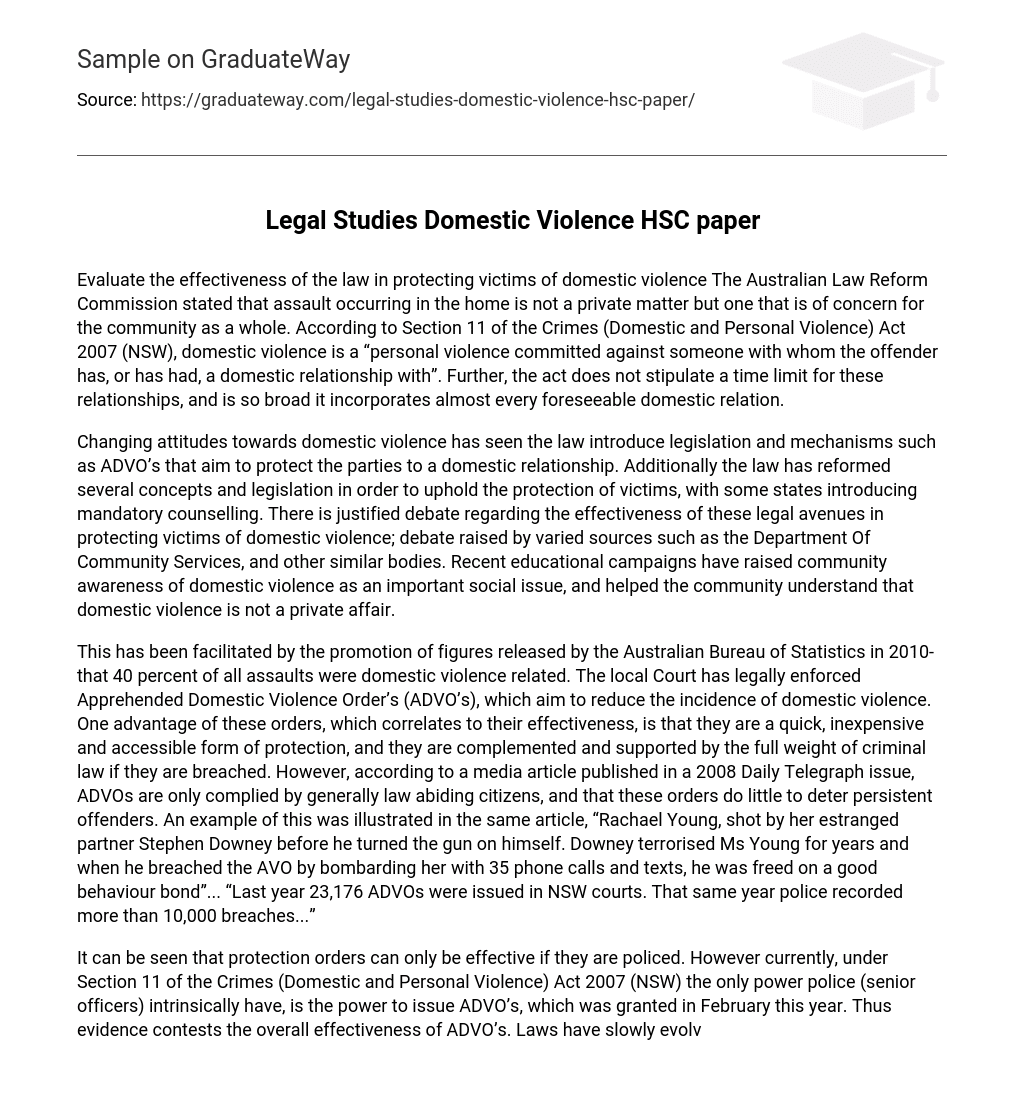Evaluate the effectiveness of the law in protecting victims of domestic violence. The Australian Law Reform Commission stated that assault occurring in the home is not a private matter, but one that is of concern for the community as a whole. According to Section 11 of the Crimes (Domestic and Personal Violence) Act 2007 (NSW), domestic violence is personal violence committed against someone with whom the offender has, or has had, a domestic relationship.” Furthermore, the act does not stipulate a time limit for these relationships, and it is so broad that it incorporates almost every foreseeable domestic relation.
Changing attitudes towards domestic violence have seen the law introduce legislation and mechanisms such as ADVOs that aim to protect the parties in a domestic relationship. Additionally, the law has reformed several concepts and legislation to uphold the protection of victims, with some states introducing mandatory counseling. There is justified debate regarding the effectiveness of these legal avenues in protecting victims of domestic violence, a debate raised by varied sources such as the Department of Community Services and other similar bodies. Recent educational campaigns have raised community awareness of domestic violence as an important social issue and helped the community understand that domestic violence is not a private affair.
This has been facilitated by the promotion of figures released by the Australian Bureau of Statistics in 2010, which showed that 40 percent of all assaults were domestic violence-related. The local court has legally enforced Apprehended Domestic Violence Orders (ADVOs), which aim to reduce the incidence of domestic violence. One advantage of these orders, which correlates to their effectiveness, is that they are a quick, inexpensive, and accessible form of protection. They are complemented and supported by the full weight of criminal law if they are breached. However, according to a media article published in a 2008 Daily Telegraph issue, ADVOs are only complied with by generally law-abiding citizens, and these orders do little to deter persistent offenders. An example of this was illustrated in the same article: “Rachael Young, shot by her estranged partner Stephen Downey before he turned the gun on himself. Downey terrorized Ms. Young for years, and when he breached the AVO by bombarding her with 35 phone calls and texts, he was freed on a good behavior bond.” “Last year, 23,176 ADVOs were issued in NSW courts. That same year, police recorded more than 10,000 breaches…”
It can be seen that protection orders can only be effective if they are policed. However, currently, under Section 11 of the Crimes (Domestic and Personal Violence) Act 2007 (NSW), the only power police (senior officers) intrinsically have is the power to issue ADVOs, which was granted in February of this year. Thus, evidence contests the overall effectiveness of ADVOs. Laws have slowly evolved in response to circumstances that legislators or the courts had not considered. The Crimes (Domestic and Personal Violence) Act 2007 (NSW) has extended the concept of ‘battered women’s syndrome’, which originally only applied to women in heterosexual relationships, to include partners in De Facto and same-sex relationships. Additionally, the automatic presumption in favour of bail was removed from Section 9A of the Bail Act 1978 (NSW) and amended in 1993 in response to the murder of a woman by her estranged husband, who had been released on bail after he had been arrested for breaching an ADVO.
The law responding to instances of domestic violence is effective. Additionally, the Firearms Act 1996 (NSW) offers additional protection by prohibiting the issuance or revocation of a gun license or permit if an individual is subject to an ADVO. All of these legal reforms have been in response to community pressure to maintain an effective legal system to protect victims of domestic violence. Currently, NSW does not have any mandatory counseling programs; however, several other states have introduced such measures for perpetrators of domestic violence. The effectiveness of such a program is currently unknown. Further law reforms are processing in response to severe instances of disturbing domestic violence attacks.
A media clip by ABC in 2009 narrated the tragic murder/manslaughter of a seven-year-old child in NSW’s Hunter Valley, following her starvation to death. Shortly after, DOCs released a statement stating that the whole child protection system underwent an extensive, independent review by Commissioner (James) Wood, and the government responded with a funded five-year plan.” The plan aims to achieve effectiveness by closely working with families in crisis and obtaining the help and support of the community.
Moreover, a NSW Domestic Violence Intervention Court Model has been sketched; however, thus far, it has met with limited success. The strategy aims to encourage police and courts to adopt a more proactive approach to domestic violence, including improvements in the collection of evidence, better support for victims, and the referral of perpetrators to appropriate counseling programs. The poor effectiveness has been determined by the lack of change in domestic violence offenses, despite statements that victim support has been satisfactory. Legal measures to protect victims of domestic violence have predominantly been disappointing. Despite legal reforms, the lack of police enforcement and the unchanging statistics of domestic violence instances negatively comment on the effectiveness of the law in achieving protection for domestic violence victims.





